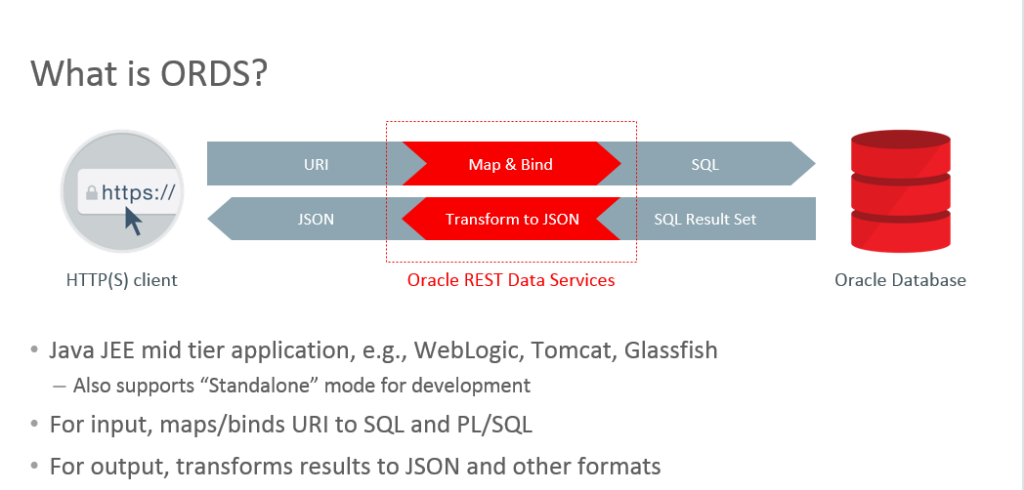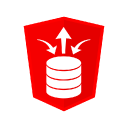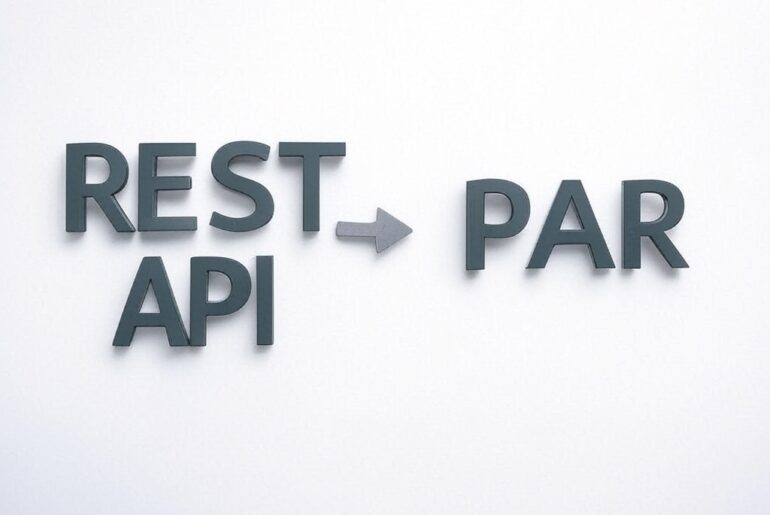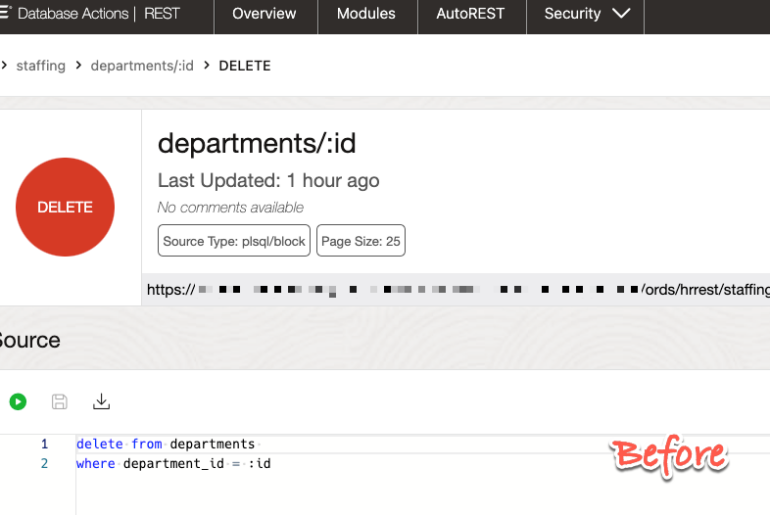Can you?
YES. Absolutely, even.

Go from your app to your Oracle Database resources via REST (GET|POST|PUT|DELETE), and your responses come back via JSON. No APEX required.
And even better, you can have ORDS up and running in less than 5 minutes.
Ok, but what about ORDS & APEX?
If you want to provide a RESTful API for your Oracle Database, then ORDS is for you. But, when I do talks on ORDS, I ask the room, who in here is an APEX Developer?
The answer to this question very much determines who the audience comes to the talk in terms of expectations and experience with ORDS.
To run APEX, you need a ‘Web Listener’ – that is, you need a service that can handle the http(s) traffic to and from the database – which is where APEX runs. It runs in the database, because APEX is built with PL/SQL. That’s also why it’s so fast – PL/SQL in the database is awesome when you want to get to your Oracle data and ‘do stuff’ with it.

So how do you get from your browser or mobile app to the database?
You have a few options today, and ORDS is the recommended way to go – version 3.0.9 is currently available for your APEX and/or REST needs.
If you want to create and deploy RESTful services for your APEX app, then ORDS is DEFINITELY the way to go. When you install ORDS, it has a few questions regarding APEX, and it’ll also offer to migrate any RESTful Services you have defined in APEX over to ORDS.
So ORDS does have a ton to offer to the APEX developer other than just being the vehicle that gets you to the database where APEX is installed.







35 Comments
Hi Jeff,
Thanks for the update.
Unless your app has really inefficient code, a very tiny VM could easily satisfy 50 concurrent users – in terms of running a connection pool for ORDS on the compute node.
In this case, a compute VM with 2 OCPU can handle 100 connections. We have got only 8GB RAM for this compute node. Is this enough to handle 50 concurrent connections?
Approximately based on your experience.
Thanks,
SG
Probably, spin it up, run your app under load, and see for yourself.
Dear Jeff Smith,
Need your expertise.
Customer has got the below quote from Oracle. Not sure whether database is autonomous or DBCS.
Oracle Base Database Service – Enterprise Edition OCPU
Virtual Machine(VM.Standard3.Flex) – Compute Standard-X9 OCPU
We have got 2 load balancers – One for PROD and one for UAT
Concern is:
1) Who is going to install the apex as per above environment.
2) Is that Compute OCPU provided by oracle ->Is it to install ORDS. If yes, is it customer who needs to install ORDS?
3) If customer has to install the ORDS & Apex->Is VPN mandatory to connect to backend ords server
Thank You,
Satish
You’re talking about a ‘customer’ and the customer is not, you?
I’m not sure I understand the relationship here, it sounds like you’re working with consultants or even Oracle Consulting?
Hi jeff,
Apologies. I am dba from client, not dealing with oracle consultancy. I have to understand whether we have to install Apex and ords from our end in oracle base database service or will Oracle will do it.
Thank you
Thank You
It’s your database, we’re not going to touch it except for the agreed upon maintenance tasks for your service. That doesn’t include installing/maintaining APEX and ORDS.
Hi,
Thanks for the article. It helps.
We are planning to deploy ORDS in one server and apex installed in oracle database in different server. We are looking for how many OCPUS to deploy for ORDS. We will have maximum 50 concurrent users to access the apex application.
Can you please let us know how many connections does a single OCPU support? Just approximately from your expertise.
Thank You,
SG
Unless your app has really inefficient code, a very tiny VM could easily satisfy 50 concurrent users – in terms of running a connection pool for ORDS on the compute node.
If you’re asking about the database itself, you’ll have a SHARED POOL, so maybe 10-20 connections max handling requests for ’50 real people.’ I’d go fairly low, and then load test your system, add oCPU as needed, vs starting high and coming down.
I would like to install ORDS on a separate weblogic server and connect to existing ORDS enabled Oracle database. Is it possible or should it be done as a new installation? If so, can anyone give me steps to do so. I am new to ORDS and Oracle dba tasks too.
ords has 2 pieces, what goes into the database, and the software itself
you can have multiple ords running, all connected to the same database if you’d like
the first thing that will happen when you add a database to ords, is it will check to see if the database install has happened already. if it has, it just starts up. if not, it’ll do the install for you then.
so if your database is already ords enabled, you can drop ords into wls and start it up with the config files pointing to your database.
you just want to make sure you’re using a compatible version of ords based on what’s actually installed in the database. Don’t point a version 19 ords at a version 3 ords repo in a database – it’ll want to upgrade that if you do.
HI,
is ORDS available with Oracle 12c version 12.1.0.2.0?
We support 11gr2 and higher, so the answer is yes.
You’ll want to download a recent copy and install it in your midtier probably.
Hi Jeff, In an earlier post you said ORDS 3.0 and higher standalone is supported for production. We are trying to decide for our production environment if stand-alone mode is sufficient. I know lots of sources online in the past said standalone should not be used for production, but at this point in time in April 2018, can you address this in a little more detail or provide any additional resources to this question? We are concerned for the scalability and performance aspects as well as security requiring https with TLS. And wondering if say Tomcat was really required.
It’s fine but if you want the administrative features that Tomcat or WLS gives you…
Alex,
Thanks for the quick response, much appreciated.
I will give it a try and switch from standaone mode to Tomcat and see if that solves my problem.
Not sure how long you’ve been using APEX on RDS, but how do you like it? I have set up a POC envoronment using RDS/APEX/ORDS 17 (on separate EC2), but have not used it for production yet. I have done several typical AWS Oracle/APEX implementations (i.e Oracle on EC2 not RDS) but I am exploring RDS & APEX now
I’m on testing and exploration phase so far too 🙂 Actually, after my posts here I had to switch to other projects but now I’m going to switch back and see how it goes. Right now I’m developing a REST API using ORDS on local Oracle 12.2.
Overall, I’m not a major fan of AWS or any other limited/crippled environment. Unfortunately, it doesn’t look like Oracle is planning to release a new Oracle XE 12, 18 or whatever…
No, we are. New XE coming out later this year. It’ll be an 18c, which is just a 12.2.0.2 update.
And our DBaaS un-managed service allows you to do pretty much anything you want on it, if you’re looking for a hosting provider.
That’s excellent news, Jeff! Thank you for clearing that up.
Alex,
I understand the trick you made to have the ORDS schemas create successfully , but when you start ords.war, does in still ask you for sysdba username and pwd? I don’t need RESTful services in my case as I use APEX 4.2 on RDS, but I am trying to find a way to have ords.war not prompt me for sysdaba credentials 3 times each time I start ORDS (I am running it in standalone mode btw). Any hint?
Hi Sam, I use Tomcat 7.0, it starts just normally, no prompts or questions.
Hi Jeff,
I was trying to install ORDS on Oracle RDS on AWS using this instruction: https://docs.aws.amazon.com/AmazonRDS/latest/UserGuide/Appendix.Oracle.Options.APEX.html
I, sort of, managed to get APEX working, however not the ORDS services per se.
Schemas ORDS_METADATA and ORDS_PUBLIC_USER are missing. And there is no access to SYS as SYSDBA, which is required to install ORDS properly.
Is there a way to install ORDS on Oracle RDS (AWS)?
checkout the AWS docs on ‘Installing and Configuring the APEX Listener’. There’s a section on there how to get ORDS. Make sure to get ORDS 3.0.12 or even 17.4 and give it a try
Yeap, this section is in the link from my first post. I followed the steps, but it looks like it fails to install correctly. After tweaking config files I managed to get APEX working, however, not the REST services. I installed my sample app and APEX REST sample app, but all the REST requests fail.
I assume ORDS_METADATA and ORDS_PUBLIC_USER are required for ORDS to work properly. However, they are missing in my DB. And I can’t run “java -jar ords.war validate” to install’em and check structure because it asks specifically for SYS as SYSDBA password which is unavailable for RDS instances
I tried a script in ords.war to install it manually, but it fails too…
The next step I was thinking of is just export all necessary schemas including (ORDS_METADATA and ORDS_PUBLIC_USER) from my local DB, which works just fine, and import everything to RDS.
By the way, I am very impressed by the way how you guys made it so accessible and easy to use. Now anyone can create REST API in just a few clicks and couple of lines of PL/SQL or SQL code.
Just to answer my own question for those having the same issue.
I managed to get APEX5.1 running with ORDS 17.4 on Amazon AWS RDS and EC2 for ords.war.
After fiddling with ords.war installation you need to run @\apex\apex_rest_config.sql under user.
It will still fail if ran unmodified, so I’ve changed a few lines of code in one of the dependent files apxpreins.sql
1) there’s a line
select cdb into l_cdb from v$database;
replace with
— select cdb into l_cdb from v$database;
l_cdb:=’NO’;
2) and a second line same file
l_apex_schema := sys.dbms_registry.schema(‘APEX’);
replace with, assuming you are running APEX 5.1
— l_apex_schema := sys.dbms_registry.schema(‘APEX’);
l_apex_schema := ‘APEX_050100’;
That did the trick.
…under master user. Sorry publishing script removed everything in < brackets
Good to hear you got ORDS going in AWS, I thought that was gonna be a show-stopper with the SYS requirement.
Hi , I have a APEX5.1 running with ORDS 17.4 on Amazon AWS RDS and EC2 for ords.war. Same as yours. But can not use #WORKSPACE_IMAGES# in APEX applications. Do you have the same issue?
Hi Jeff,
could you please further describe the realtionship between apex ords sqldeveloper?
I am going to move
from old) Oracle-DB V10.2/Apex V4.2/ORDS V2 with REST-defined-in-Apex (of course)
to new) Oracle-DB V11.2/Apex V5.1/ORDS V17.4 with REST-defined-in-ORDS (as you suggest)
and I am using sqldeveloper V17.3
The initial setup of the new stack is done without any application / REST-modules defined.
(–> so at the time when ords is installed there is nothing that it could offer to be migrated.)
Currently in old) sqldeveloper allows me to view and edit REST that is in APEX.
Now when connecting to new) I assume the it would be possible to put REST into APEX in V5.1 also even if it
is not suggested?
How would sqldeveloper know where to put the REST definition? To ords or to apex?
For the migration: old) allows to export the REST-definition.
Where do I import the sql-File so that it goes to ords and not to apex in new)?
Thank you
Christian
You had me up to here
sqldeveloper allows me to view and edit REST that is in APEX.
No, SQL Developer only shows you and allows you to dev/edit the RESTful Services in the ORDS Repository.
When you install and configure ords for your DB, it will offer to migrate your RESTful Services from APEX over into ORDS. Have you tried this?
no, the new) stack is not yet installed completely.
But I tried on another system: DB = 12c, apex = 512, ords = 309, an apex-app running,
no rest so far (in the apex ide / sql-workshop no module is shown)
I created an admin-account in ords (java -jar ords.war user ordsdev “SQL Developer”).
Then I was able to connect from sqldeveloper/REST-Development. It showed an empty list – no surprise.
Now in sqldeveloper I created a module with a GET (select sysdate from dual) , validated and did the upload.
And now this moduled is shown in APEX-IDE’s SQL-workshop/Restful-services. Surprise here.
Now I wonder if my rest-module is defined in apex or in ords and how I can control/determine this.
Or does the apex-ide act as another dev-tool for the ords-based rest?
what you’re describing shouldn’t be possible
Hi, I was playing around with ORDS and creating templates/handlers etc via the ORDS package (which I’ve done successfully), i.e. not as RESTful Services within Apex, these are completely standalone.
I’m then trying to protect them with OAUTH2 using the OAUTH package and again fine and works well but only if I use the unsupported for production use file-system user repository, i.e. via $ java -jar ords.war user .
What I’m trying to work out is if I can configure ORDS to validate the entered user credentials (in authorization or implicit flows) against either an Apex user repository (again, via the ORDS / OAUTH packages only) or indeed via a custom “users” table?
Do you know if this is possible?
Regards
>>only if I use the unsupported for production use file-system user repository
I don’t understand this.
ORDS 3.0 and higher standalone is supported for production.
How do you configure ORDS using WebLogic without using APEX?
ords installs are ords installs – WebLogic doesn’t really change anything. Are you having a specific problem?